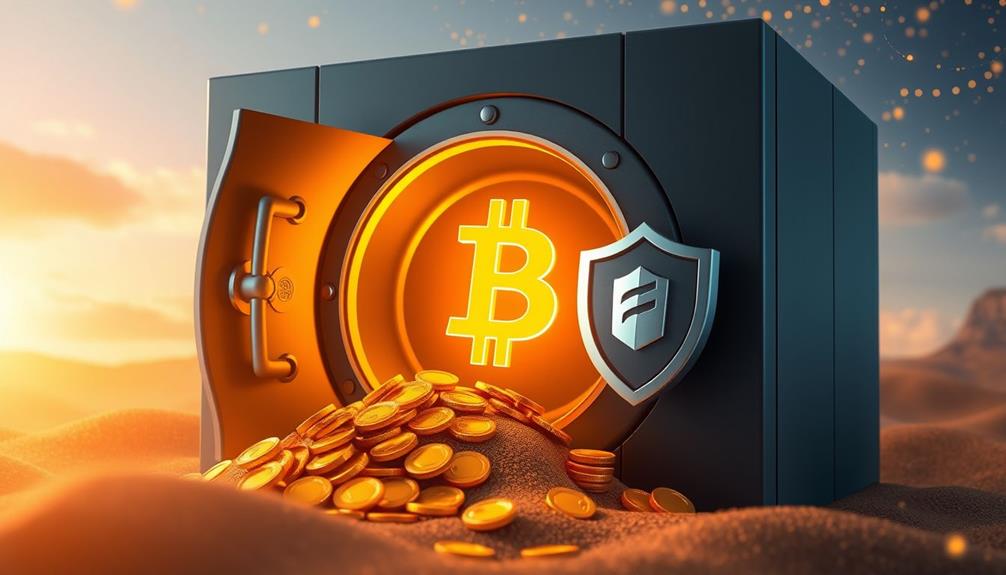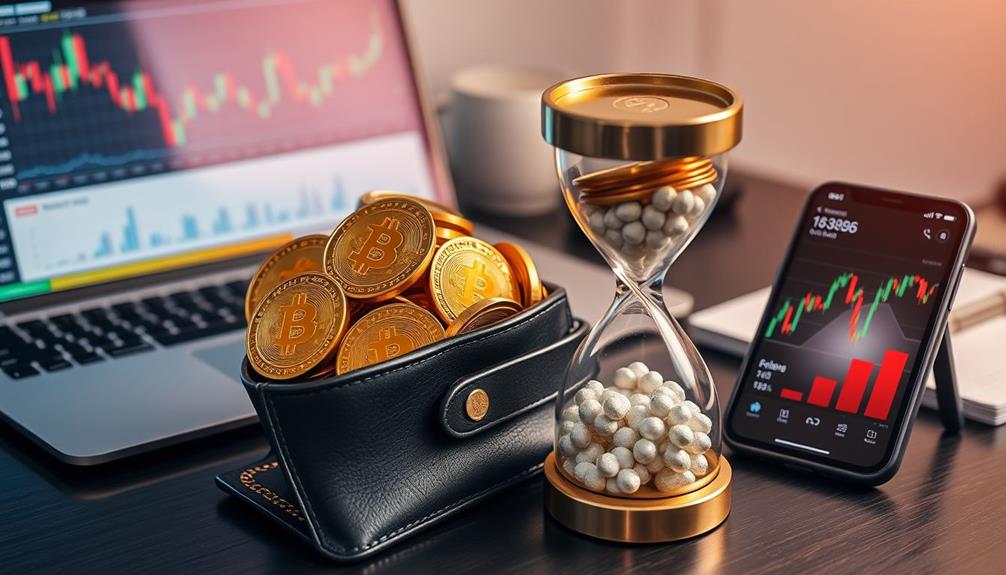Securing your Bitcoin IRA is essential, as it can save you thousands in potential losses. Start by choosing a reputable custodian with robust security measures like multi-signature wallets. Self-custody of your assets provides true ownership and reduces reliance on third parties. Conduct regular security assessments and stay informed about IRS regulations to navigate compliance effectively. It's also wise to compare various cryptocurrency options and understand the tax implications of your IRA. These proactive steps are just the beginning; there's more insight available to help you maximize the security of your investment.
Key Takeaways
- Utilize multi-signature wallets for enhanced security, requiring multiple approvals for transactions to reduce risks of theft and unauthorized access.
- Choose custodians with robust security measures, including end-to-end insurance, to protect your Bitcoin IRA assets from potential losses.
- Implement self-custody options to maintain true ownership of your Bitcoin and lower reliance on third-party custodians, minimizing risks of account hacks.
- Regularly assess your custodian's security features and stay informed about the latest trends and regulations in the cryptocurrency space.
- Educate yourself on tax implications and contribution limits for Bitcoin IRAs to maximize your retirement savings potential effectively.
Understanding Bitcoin IRAs

When you're looking to diversify your retirement portfolio, understanding Bitcoin IRAs is essential. These self-directed IRA accounts are specifically designed to hold cryptocurrencies, allowing you to invest in Bitcoin and other alternative assets beyond traditional stocks and bonds. This can be a smart way to hedge against market volatility and increase your potential returns, much like how gold IRAs can protect against inflation.
In 2023, you can contribute up to $6,500 if you're under 50 or $7,500 if you're 50 and older, with tax advantages available through either traditional or Roth IRA options. However, it's crucial to recognize that you'll need IRA custodians to manage your Bitcoin IRA and guarantee compliance with IRS regulations. Leading Bitcoin IRA providers like BitIRA and iTrustCapital can help direct you through the process.
While investing in Bitcoin through an IRA can offer significant benefits, it also comes with complexities and higher risks due to cryptocurrency's inherent volatility.
Benefits of Securing Your IRA

Securing your Bitcoin IRA is vital for protecting your hard-earned retirement savings. By implementing robust security measures, you not only safeguard your investment from potential hacks but also guarantee that your assets remain intact amid market volatility.
Utilizing custodial services that offer multi-signature solutions considerably reduces the risk of unauthorized access, giving you peace of mind. Additionally, it's important to understand the risks and rewards of Bitcoin IRAs to make informed decisions about your investment strategy.
When you choose to secure your Bitcoin IRA, you take control over your retirement funds. Options like cold storage provide an added layer of protection, and self-custody solutions allow you to retain control over your private keys. This way, you're not reliant on third-party custodians who may be vulnerable to security breaches.
Moreover, securing your Bitcoin IRA alleviates concerns about regulatory changes and potential government interventions. By proactively managing your investment, you can navigate the complexities of the market with confidence.
Investing in educational resources and strategies on Bitcoin security further enhances your understanding of best practices, helping you avoid costly mistakes that could jeopardize your retirement.
Ultimately, securing your Bitcoin IRA is about taking charge of your financial future.
Importance of Self-Custody
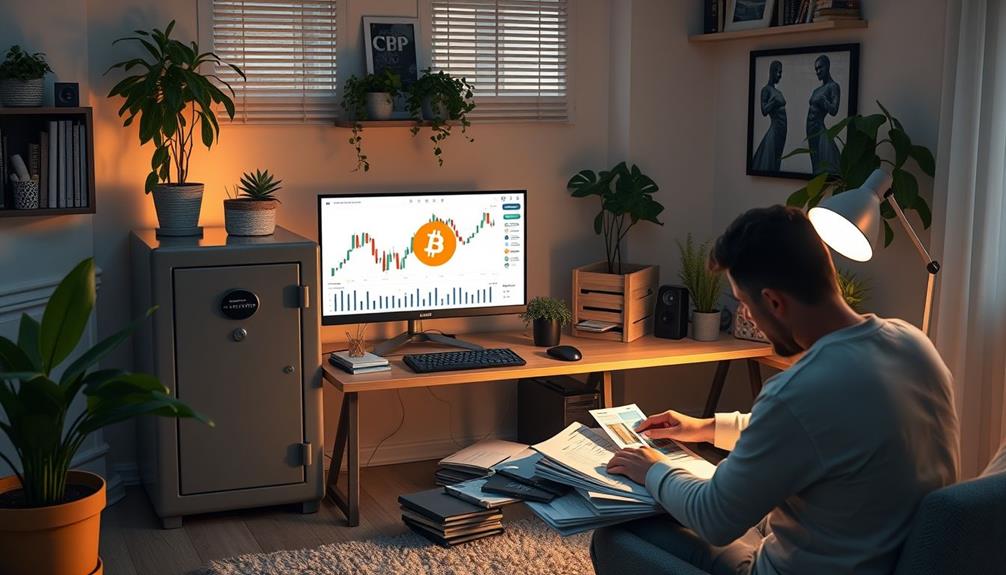
When you choose self-custody for your Bitcoin IRA, you're taking control of your assets like never before.
This not only enhances your security through measures like multi-signature solutions but also gives you peace of mind knowing that you're the only one managing your keys.
Control Over Assets
Taking control of your Bitcoin IRA assets is essential for guaranteeing true ownership and security. By utilizing self-directed IRAs and self-custody options, you can hold your own private keys, reducing reliance on Bitcoin IRA companies and minimizing risks such as account hacks or freezes. The mantra "Not your keys, not your coins" underscores the importance of retaining control over your assets.
| Custody Option | Benefits |
|---|---|
| Self-Custody | Direct access to private keys, full control |
| Multi-Signature | Enhances security by requiring multiple keys |
| Third-Party Custody | Relies on custodians, higher risk of freezes |
Implementing multi-signature solutions adds an extra layer of security, requiring multiple keys to authorize transactions. This reduces unilateral control and potential asset seizure. By choosing self-custody, you can navigate regulatory changes confidently, knowing you have direct access to your cryptocurrency.
Educational resources are available to help you understand the complexities of managing your Bitcoin IRA assets. By taking these steps, you'll enjoy peace of mind and guarantee the security of your investments.
Enhanced Security Measures
One key advantage of self-custody is the ability to maintain full control over your private keys, which drastically lowers the risk of losing assets due to exchange hacks or custodial failures.
By choosing self-custody for your Bitcoin IRA, you guarantee that your funds are secure and accessible only to you.
A powerful tool in this domain is the multi-signature wallet. This setup requires multiple approvals for transactions, making it remarkably harder for unauthorized individuals to access your funds.
Using a multi-signature wallet alongside proper security practices can enhance your overall asset protection.
Providers like Unchained IRA offer solutions that empower you to hold your private keys, further mitigating risks associated with third-party custodians.
However, it's vital to understand that self-custody demands a solid grasp of security practices. Improper management of your private keys can lead to irreversible losses, so take the time to educate yourself on best practices.
In today's landscape, where scams and fraud are rampant, self-custody allows you to take charge of your Bitcoin assets, implementing personalized security measures to protect your wealth effectively.
Multi-Signature Wallets Explained

Multi-signature wallets provide an innovative approach to securing your Bitcoin assets by requiring multiple private keys for transaction authorization. This setup not only enhances security but also guarantees that no single key can compromise your wallet. A common configuration, the 2-of-3 setup, requires two out of three keys to execute a transaction, striking a balance between security and accessibility.
Here's a quick overview of how multi-signature wallets work:
| Feature | Benefits |
|---|---|
| Multiple Key Holders | Reduces the risk of theft or loss |
| Distribution of Keys | Prevents unauthorized access |
| Consensus Required | Mitigates seizure risk |
| User Control | You control your keys vs. relying on traditional custodial services |
Choosing the Right Custodian
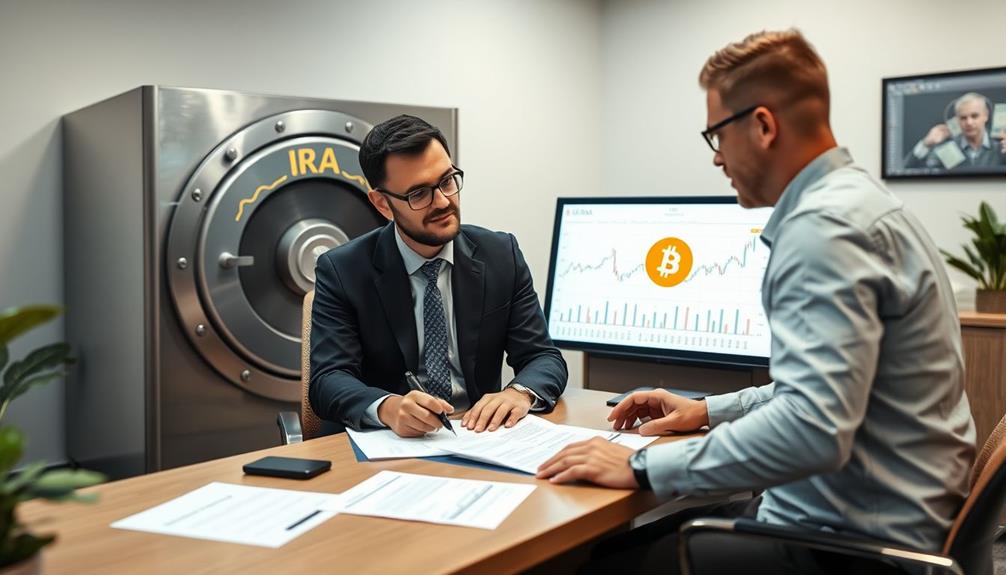
When you're choosing a custodian for your Bitcoin IRA, you need to evaluate their fee structures, security features, and the variety of cryptocurrency options they offer.
Make sure the fees won't eat into your returns and that they've strong protection against hacks.
It's essential to find a custodian that aligns with your investment goals and provides a secure, flexible trading environment.
Evaluate Fee Structures
How do you guarantee you're choosing the right custodian for your Bitcoin IRA? Start by evaluating the fee structures involved. Many platforms, such as iTrustCapital and AltoIRA, boast $0 monthly fees, while others may have higher setup and management costs.
The average one-time setup fee for Bitcoin IRAs hovers around $745, and annual fees can range from $250 to over $1,000, depending on what services and asset management options the custodian offers.
Don't overlook trading fees, either. Custodians like BitIRA implement tiered pricing for trades, which can greatly impact your investment returns. It's essential to understand how these fees stack up against potential benefits.
For example, if a custodian provides end-to-end insurance on assets, the higher fees might be justified if it adds an extra layer of security.
Lastly, keep in mind any additional costs, such as hardware wallets, which can add about $75 each to your total investment. By carefully comparing custodians and their fee structures, you can make an informed decision that safeguards your Bitcoin IRA and maximizes your investments.
Assess Security Features
Selecting the right custodian for your Bitcoin IRA is essential, especially when it comes to security features. Prioritize custodians that offer robust measures like multi-signature wallets. These require multiple keys to authorize transactions, greatly reducing the risk of hacks or unauthorized access.
Look for custodians with a solid reputation and those regulated by trusted authorities. Providers like BitIRA and I Trust Capital not only offer end-to-end insurance on assets but also provide peace of mind against potential losses.
Investigating the custodian's insurance policies is imperative; some cover theft or loss, protecting your investments from unforeseen circumstances.
Additionally, assess the custodian's track record regarding security breaches and their response protocols. A history of reliable security measures indicates better overall risk management.
It's also essential to verify the custodian's compliance with IRS regulations and their experience in managing cryptocurrency IRAs. This expertise is critical for effectively safeguarding your retirement assets.
Compare Cryptocurrency Options
Choosing the right custodian for your Bitcoin IRA means comparing the cryptocurrency options they support. You'll want to evaluate how many and which cryptocurrencies you can include in your investment account. For example, Bitcoin IRA offers over 60 options, while BitIRA limits you to just 9.
Here's a quick comparison to help you evaluate:
| Custodian | Supported Cryptos | Annual Maintenance Fee | TrustPilot Rating |
|---|---|---|---|
| Bitcoin IRA | 60+ | Varies | 4.5 |
| BitIRA | 9 | $200 | 4.1 |
| iTrustCapital | 25 | $0 | 4.7 |
| IRA Financial | 15 | Varies | 4.3 |
Additionally, look into the fee structures, security measures, and educational resources they provide. For instance, iTrustCapital has no monthly fees and a $1,000 account minimum. Make sure to read customer reviews and consult with a financial advisor if needed. Choosing wisely can save you thousands in the long run!
Regular Security Assessments
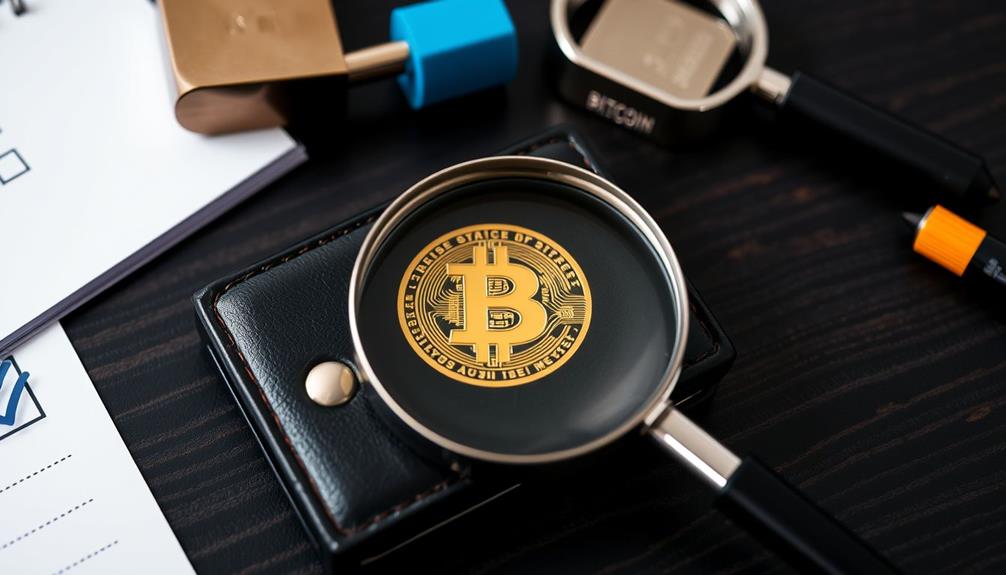
Regular security evaluations are essential for protecting your Bitcoin IRA from potential threats that could lead to financial losses. By regularly reviewing your security measures, you can guarantee your assets remain safe from hacks and unauthorized access.
Here are some key practices to implement:
- Conduct periodic audits of your custodial provider's security measures.
- Utilize multi-signature wallets and end-to-end encryption for added protection.
- Stay alert to potential threats like phishing scams targeting IRA accounts.
- Implement two-factor authentication (2FA) for all your Bitcoin IRA accounts.
- Keep informed about the latest security trends and breaches in the cryptocurrency industry.
These strategies help you identify vulnerabilities before they become costly problems. Regularly evaluating your security not only fortifies your investments but also builds trust in your custodial provider.
Staying Informed on Regulations
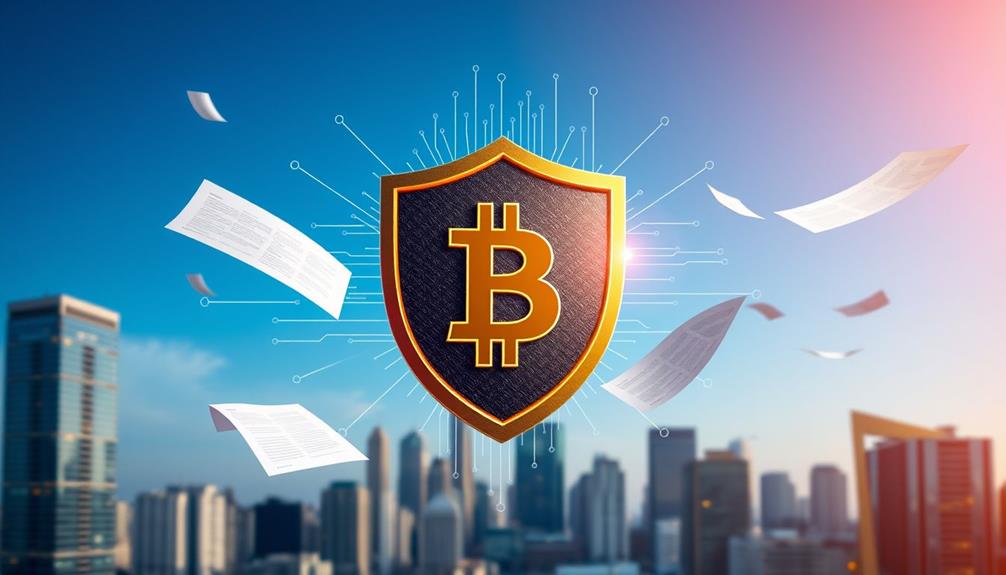
Maintaining robust security measures for your Bitcoin IRA is just one part of the equation; understanding the regulatory landscape is equally important. Staying updated on IRS regulations is essential since they classify Bitcoin as property. Since 2014, specific rules for taxation and reporting have been in place, so make sure you're compliant.
Regularly check for announcements from the CFTC and SEC, as they often issue warnings about fraudulent crypto IRA companies and potential regulatory changes. Keep an eye on custodial requirements, as security measures and insurance options can vary greatly among providers, impacting your Bitcoin IRA's safety.
You should also be aware of the potential for government intervention in cryptocurrency markets. Historical precedents like Executive Order 6102 serve as reminders of how regulations can shift overnight.
Consulting with certified financial advisors who understand current crypto regulations can provide invaluable financial advice. They'll help you navigate compliance issues and make informed decisions regarding your IRA accounts.
Tax Implications of Bitcoin IRAs

How do the tax implications of a Bitcoin IRA affect your investment strategy? Understanding these factors is vital for maximizing your returns and avoiding unexpected costs. Here are some key points to take into account:
- Contributions to a Bitcoin IRA are limited to $6,500 for those under 50 and $7,500 for those 50 and older.
- Traditional Bitcoin IRAs offer tax-deferred growth, while Roth Bitcoin IRAs allow for tax-free withdrawals if conditions are met.
- Trading within your Bitcoin IRA won't trigger capital gains taxes, enabling your investments to grow tax-free as long as the funds stay in the account.
- The IRS mandates detailed reporting of cryptocurrency transactions, so keeping meticulous records of your purchases, sales, and trades is essential.
- Withdrawals are treated like traditional IRA withdrawals, meaning they incur ordinary income tax, and early withdrawals (before age 59½) could face a 10% penalty.
Continuous Education on Best Practices

Staying informed about the latest developments in Bitcoin IRAs is key to optimizing your investment strategy. Continuous education is essential for making informed investment decisions.
Regularly attend webinars and educational sessions hosted by Bitcoin IRA providers to stay updated on trends and best practices in cryptocurrency investment. These sessions can provide insights into tax advantages and security measures associated with crypto IRAs.
Utilize extensive resources like Bitcoin IRA handbooks and guides to deepen your understanding. Engaging with online communities and forums focused on Bitcoin IRAs can also be beneficial; sharing experiences with other investors helps you learn effective strategies and identify potential pitfalls.
Don't forget to take advantage of on-demand replay options for any educational sessions you might miss. This way, you won't miss important information that could impact your investments.
You might also consider enrolling in paid courses that explore specific topics, such as estate planning for Bitcoin and secure storage solutions.
Frequently Asked Questions
Is Bitcoin IRA Legitimate?
Yes, a Bitcoin IRA is legitimate. It allows you to hold cryptocurrencies in a tax-advantaged account. However, you should research providers carefully and consider your risk tolerance before investing in such a volatile asset.
How Much Does a Bitcoin IRA Cost?
A Bitcoin IRA typically costs around $745 for setup, plus an annual fee of $250. Additional charges like trading fees and concierge services can add up, so consider these when planning your investment.
Can You Withdraw Money From Bitcoin Ira?
Withdrawing from a Bitcoin IRA is like maneuvering through a maze; it's possible, but you've gotta watch for tax implications and penalties. If you meet the guidelines, you can access your funds, just be cautious!
What Is the Bitcoin IRA Program?
A Bitcoin IRA program lets you invest in cryptocurrencies like Bitcoin within a self-directed retirement account. You can choose between traditional and Roth options, benefiting from potential tax advantages while diversifying your retirement portfolio.
Conclusion
In the ever-shifting landscape of Bitcoin IRAs, securing your investment is like fortifying a castle against unseen invaders. By embracing self-custody, opting for multi-signature wallets, and selecting the right custodian, you're not just protecting your wealth; you're planting seeds for financial growth. Remember, staying informed and educated is the compass that guides you through this digital wilderness. So, arm yourself with knowledge, and watch your assets flourish in the garden of opportunity.

